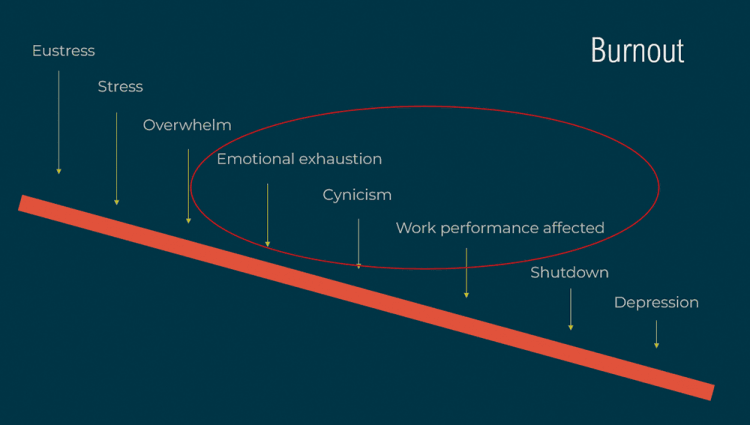
Burnout: that dreaded state that nobody wants to admit to, especially if you are a leader. No wonder we have more people experiencing it and speaking about it. In fact, the word is mentioned so often that it threatens to become boring, ignored, or fall into the shadow of cliché. That alone should be a warning to society and businesses – if we do not take it seriously, it is going to take us down.
The World Economic Forum has recently formally acknowledged burnout as an occupational syndrome, giving it a status that is even more worthy of being taken seriously and resolved as quickly as possible. Byung-Chul Han warns us in his book Burnout Society that we are permissive and passive about burnout and that we treat it as an acceptable part of being highly productive.
What is it
Being tired is not burnout. Feeling really stressed is not burnout. Feeling exhausted is not burnout. There are 3 specific measures that indicate the existence of burnout:
1. Emotional exhaustion – where your emotional reserves are depleted, you feel completely overwhelmed, and you can experience powerlessness, irritability, anxiety, apathy and even depression. We can all feel some of these things on a daily basis, but true emotional exhaustion is debilitating. You cannot pull out of it very easily.
2. Cynicism or depersonalisation – which is a way of putting up a shield between you and your colleagues or peers as a way of trying to distance yourself from others. Your emotional exhaustion may have reached a point that certain or most conversations with others require resources you just no longer have. There is very little emotional energy left to invest in relationships.
3. Perceived decrease in effectiveness at work – which is essentially a feeling that you are unable to bring to your role the productivity and attention you want or need or are used to. Whether this is true or not, is not the issue. It is the perception you have that counts here.

The slippery slope to shutdown
Our roles and work relationships take an emotional and mental toll on us. There is nothing inherently wrong with that. Stress is part of the human experience and, in small measure, is a good thing. It helps us get off the couch and bring our gifts and talents to the world.
It is when we do not allow our mind and body to recuperate, when we do not replenish and reboot after a really tough project or intense emotional difficulty, that we slide towards burnout. When we have allowed the world to chip away and chip away at us until we have no defences left, when we can no longer manage even the most basic task or conversation – we have slipped too far and potentially reached a state of shutdown or worse, clinical depression.
This, to my mind, is the danger of not knowing enough about burnout. It is insidious – we do not notice it creeping up and taking over our bodies, our minds, our relationships and our spirit. Figure 1 may not be medically sound and has not yet been tested through research but, in my experience with the clients I have worked with, it is often an accurate depiction of what can happen when we do not address the slippery slope.
How do we get burnout
Burnout does not only come from work overload. There are certain personality types who are more likely to push themselves beyond the capacity of their nervous system – think the driven, perfectionist, Type A personalities. Also, high levels of ambiguity can have an impact; when employees are punished for not following procedures or meeting objectives despite job roles being unclear and protocols being unclear.
An overload of information is particularly an issue in our current society with mass media bombarding us all day every day. It is often tricky to discern what information to take on and what not.
The bleeding between work and home means the boundaries between these different contexts have become highly permeable and we have not yet learned to manage this level of permeability. I say yet, because I believe as these boundaries become more entangled, we will become better at trying to navigate a way through – certainly we have a duty to figure it out, sooner rather than later.
There are many other causes of burnout and a multitude of academic research that supports some very interesting and multi-layered models, but at this point let us look at how we actually deal with this scourge.
The Antidote
I wish I could suggest that you just take a magical, burnout pill. Of course, many of us self-medicate with painkillers or benzodiazepines, but that just makes it worse in the end. Sometimes the antidote is simple. Most often it is not. It depends on the individual.
There is an argument that grit is what gets us through. Yes and no. We can see how many of the children today are grappling with struggle and perhaps would benefit from learning that effort and grit is part of life. Duckworth says in her bestselling book Grit, that we can be distracted by talent and forget that effort is worth twice as much.
However, I would argue that too much grit when you are already overwhelmed by stress is only going to push you towards burnout faster and harder. This is where resilience comes in. We know that resilience is often defined as the ability to bounce back after adversity. This definition focuses on the past, on the ability to return to a previous state. When we are growing and learning and changing, returning to a previous state is not always useful. In fact, we need to be stepping into a new state as often as we can, building the capacity to take on the constant change happening around us.
The word Prosilience, on the other hand, is more apt in describing the antidote I believe is key to facing the burnout pandemic. It reflects a trending term in current resilience circles, that of anti-fragility. To my mind, Prosilience as well as anti-fragility, involve the active intention to build resilience muscles for the success of your future self. It invites us to acknowledge the strength and resilience we already have and encourages us to embrace and add to our internal power for the sake of our future selves.
What we can do
Different approaches are required if we are trying to prevent burnout as opposed to recover from burnout. In preventing burnout the focus must be on close monitoring of what is happening with your body, your mind and your emotions. You can easily build a habit of checking in with yourself every day or so and asking “what is going on with my emotions today? What is going on with my body? Is it okay today? Is there anger or frustration from the week that I am holding on to and have not released? What is the state of my mind right now?” The challenge here is to take those few moments and check in and not to, for example, grab a beer or get onto social media or call someone as a way of distracting yourself.

There are a multitude of things you can do like becoming aware of what tends to push your buttons or getting out in front of your work to help you feel on top of things. Humour is one of the most powerful ways of releasing negative emotions and keeping your perspective rational. Sometimes it merely takes watching a funny video before you go to bed each night to reset from your work day and enter the sleep state with a smile on your face.
If work circumstances are overwhelming you, consider speaking to your line manager about shifting some of your tasks, even if it is just for a short period of time, or taking a long leave break during which there should ideally be fun activities and excursions as well as solid rest. Each individual will have an ideal mix of counter measures depending on their personalities, the work they do and their life circumstances.
This goes for recovering from burnout as well, which requires a different approach. You may need what I call Radical Rest where you allow the whole of your system to calm into your parasympathetic nervous system as often as possible. It may involve you connecting with a burnout professional to reboot your nervous system and release cognitive and emotional burdens. You may require medical intervention for temporary medications to rebuild andrenal health. Some studies support what two of my clients needed in order to pull through burnout – a sabbatical. However, this is not always possible for everyone.
In closing
Burnout does no good at all to our organisations. We need our leaders to be growing and leading and inspiring our employees. We need our employees to be focused, productive and enthused to keep building their talent. We need our companies to be developing cultures of resilience and engagement. We need every bit of success and profitability that we can muster for our future selves. It can be done.
For more information contact Glynis Penny, Futurae,

© Technews Publishing (Pty) Ltd. | All Rights Reserved.